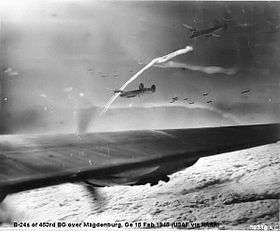733d Bombardment Squadron
| 733d Bombardment Squadron | |
|---|---|
|
Consolidated B-24 Liberators of the 453d Bombardment Group on a mission over enemy-occupied territory. | |
| Active | 1943-1945 |
| Country |
|
| Branch | United States Army Air Forces |
| Role | Bombardment |
| Engagements | European Theater of World War II |
The 733d Bombardment Squadron is an inactive United States Army Air Forces unit. It was last assigned to the 453d Bombardment Group, stationed at Fort Dix Army Air Base, New Jersey. It was inactivated on 12 September 1945.
History
Training
The 733d Bombardment Squadron was activated in mid 1943 as a Consolidated B-24 Liberator heavy bombardment squadron.[1] The squadron trained under II Bomber Command. The 733d trained in Idaho[1] for the first phase of training which included local area flights, bombing and aerial gunnery practice. The unit moved to California[1] for the second and third phases of training. The training there was more extensive. It included cross country missions, navigation problems, gunnery, bombing and pilot training problems. At this time considerable time was spent in ground school instruction on problems pertaining to heavy bombardment operations for overseas duty.
Combat in the European Theater
The 733rd deployed to the European Theater of Operations (ETO), where it became part of VIII Bomber Command in England in December 1943. The squadron engaged in long-range strategic bombardment of enemy targets in Occupied Europe and Nazi Germany. It flew its first combat mission on 5 February 1944 against an airfield at Tours, France. Its targets included a fuel depot at Dulmen, marshalling yards at Paderborn and Hamm, aircraft factories at Gotha, an ordnance depot at Glinde and oil refineries at Gelsenkirchen, chemical factory at Leverkusen and airfields.The squadron took part in the Big Week concentrated attack against the German aircraft industry at the end of February 1944.[2]
In addition to its strategic missions, the squadron carried out air support and air interdiction missions. It bombed airfields, V-1 flying bomb and V-2 rocket sites, and anti-aircraft warfare batteries in support of the Operation Overlord landings in Normandy. On D-Day the 733d attacked shore installations between Le Havre and Cherbourg. It attacked enemy troops during the subsequent breakout at St-Lo in July 1944. The squadron attacked enemy formations and armor during the Battle of the Bulge from December 1944 to January 1945.[2]
On two occasions, the squadron acted as an airlift unit, hauling gasoline, food, and blankets to France in September 1944, and dropping supplies to airborne troops near Wesel during Operation Varsity. the airborne assault across the Rhine river in 1945.[2]
The squadron returned to the United States shortly after the surrender and the unit was inactivated in September after the Surrender of Japan.[1]
Lineage
- Constituted as the 733d Bombardment Squadron (Heavy) on 14 May 1943
- Activated on 1 June 1943
- Redesignated 733d Bombardment Squadron, Heavy in 1944
- Inactivated on 12 September 1945[1]
Assignments
- 453d Bombardment Group, 1 June 1943 – 12 September 1945[1]
Stations
- Wendover Field, Utah, 1 June 1943
- Pocatello Army Airfield, Idaho, 29 July 1943
- March Field, California, c. 29 September–December 1943
- RAF Old Buckenham (AAF-114),[3] England, 23 December 1943 - 9 May 1945
- New Castle Army Air Base, Delaware, 25 May 1945
- Fort Dix Army Air Base, New Jersey, 18 June 1945 - 12 September 1945[1]
Aircraft
- Consolidated B-24 Liberator, 1943–1945[1]
Awards and Campaigns
| Campaign Streamer | Campaign | Dates | Notes |
|---|---|---|---|
| Air Offensive, Europe | 5 February 1944 – 5 June 1944 | [1] | |
| Normandy | 6 June 1944 – 24 July 1944 | [1] | |
| Northern France | 25 July 1944 – 14 September 1944 | [1] | |
| Rhineland | `5 September 1944 – 21 March 1945 | [1] | |
| Ardennes-Alsace | 16 December 1944 – 25 January 1945 | [1] | |
| Central Europe | 22 March 1944 – 21 May 1945 | [1] | |
References
Notes
- 1 2 3 4 5 6 7 8 9 10 11 12 13 14 Maurer, Maurer, ed. (1982) [1969]. Combat Squadrons of the Air Force, World War II (PDF) (reprint ed.). Washington, DC: Office of Air Force History. p. 727. ISBN 0-405-12194-6. LCCN 70605402. OCLC 72556.
- 1 2 3 Maurer, Maurer, ed. (1983) [1961]. Air Force Combat Units of World War II (PDF) (reprint ed.). Washington, DC: Office of Air Force History. pp. 328–329. ISBN 0-912799-02-1. LCCN 61060979.
- ↑ Station number in Anderson, Capt. Barry (1985). Army Air Forces Stations: A Guide to the Stations Where U.S. Army Air Forces Personnel Served in the United Kingdom During World War II (PDF). Maxwell AFB, AL: Research Division, USAF Historical Research Center. Retrieved July 7, 2012.
Bibliography
![]() This article incorporates public domain material from the Air Force Historical Research Agency website http://www.afhra.af.mil/.
This article incorporates public domain material from the Air Force Historical Research Agency website http://www.afhra.af.mil/.
- Anderson, Capt. Barry (1985). Army Air Forces Stations: A Guide to the Stations Where U.S. Army Air Forces Personnel Served in the United Kingdom During World War II (PDF). Maxwell AFB, AL: Research Division, USAF Historical Research Center. Retrieved July 7, 2012.
- Maurer, Maurer, ed. (1983) [1961]. Air Force Combat Units of World War II (PDF) (reprint ed.). Washington, DC: Office of Air Force History. ISBN 0-912799-02-1. LCCN 61060979.
- Maurer, Maurer, ed. (1982) [1969]. Combat Squadrons of the Air Force, World War II (PDF) (reprint ed.). Washington, DC: Office of Air Force History. ISBN 0-405-12194-6. LCCN 70605402. OCLC 72556.
